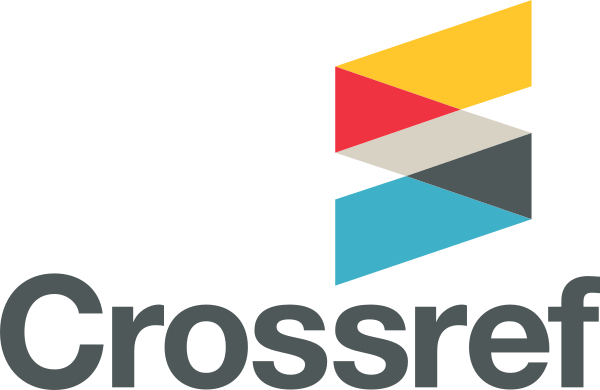JSER Policies
JSER Online
JSER Data
Frequency: quarterly
ISSN: 1409-6099 (Print)
ISSN: 1857-663X (Online)
Authors Info
- Read: 49970
|
САМО-РЕГУЛАТИВНИ СТРАТЕГИИ
ЗА ОРАЛНА КОМУНИКАЦИЈА КАЈ ДЕЦАТА СО ОШТЕТЕН СЛУХ
Алоис ГЕРГУТ
Лоредана ПАДУРАРУ
|
|
SELF-REGULATION STRATEGIES OF ORAL COMMUNICATION IN CHILDREN WITH HEARING IMPAIRMENT
Alois GHERGUT
Loredana PADURARU
|
|
Вовед
А. Banduraво истражување од 1997 годиназаклучува дека „социјално-когнитивната теорија ги спојува когнитивните, мета-когнитивните и мотивационите механизми кај само-регулирањето“ (1). Оваа теорија го проширува концептот на саморегулација во две насоки. Првата во концептот вклучува поширока група на механизми за саморегулирање кои ја контролираат когнитивната функција. Втората го дефинира концептот на саморегулирање како мотивациски и социјални способности кај поединците.
Еден од пристапите на саморегулацијата при учењето е поддржано од страна на P. Winne во 1995, кој имаше голем придонес за разјаснување на концептот за учење на саморегулација, укажувајќи дека истиот е комплексна целина која се наоѓа во опсегот на неколку области на истражување: мотивациона, когнитивна и метакогнитивна.
Факторот на разбирливост на говорот се смета од голема важност за социјалната интеграција на луѓето со оштетен слух, играјќи голема улога за нивната едукативна и професионална орентација.
|
|
Introduction
A. Bandura in a study from 1997 argues that „social-cognitive theory integrates cognitive, meta-cognitive and motivational mechanisms in the self-regulation” (1). This theory extends the concept of self-regulation in two directions. The first includes in the concept’s signification a broader set of self-regulation mechanisms that control the cognitive functioning. The second defines the self-regulation concept as the motivational and social abilities of the individual.
One of the approaches on the self-regulation of learning is supported by P. Winne in 1995, who had a major contribution in clarifying the concept of self-regulated learning, pointing out that it is a complex construct located at the crossroads of several areas of research: motivation, cognition and meta-cognition.
The speech intelligibility factor is considered to be of a great importance for the social integration of the hearing impaired people, being an essential criterion for school and professional orientation.
|
|
Специфичната терапија за стимулирање на јазикот има за цел да го поправи пренесувањето на звуци/фонеми и учењето на изговарање од страна на глувите деца, со цел да се постигне разбирлива орална комуникација. Специфичната терапија за стимулирање на јазикот ја има следната цел (6):
Читањето од усни е „визуелна перцепција на вербалниот јазик преку следење на видливите движења на фонетските органи и физиономијата на соговорникот“ (7). Формите на перцепција при читањето од уста се:
Дактилниот јазик е воведен според „градбата на раката и прстите“, а не според гестикулативните компоненти: позиција во просторот, движење, фацијални изрази и ориентација на раката. Според Pufan (8), дактилниот јазик помага при вежбање на замислено и вербално размислување, додека гестикулативниот систем е поврзан со визуелното размислување. Тоа е кореспонденција помеѓу сликите и фонемите. |
|
The specific therapy for stimulating the language of deaf students aims to correct the emission of sounds/phonemes and their learning of pronunciation to achieve intelligible oral communication. The specific therapy for stimulating the language has the following objectives (6):
The lip-reading ability is „the visual perception of verbal language by following the visible movements of the phonetic organs and the physiognomy of the interlocutor„ (7). The forms of perception of lip-reading are:
The dactylic language is implemented based on „the configuration of the hand and fingers” and not on the gesture components: position in space, movement, facial expressions and hand orientation. According to Pufan (8), the dactylic language is helpful for training notional and verbal thinking, while the gesture system is linked to the visual thinking. It is a one to one correspondence between the graphics and phonemes. |
|
|
||
|
Слика 1: Модел на мотивација според Deci |
|
Figure 1: Deci’s model of motivation |
|
|
|
|
|
Улогата на мотивационите фактори кај само-регулацијата: Учењето е обично надворешно или суштински мотивирано. Но во одредени случаи „надворешната мотивација може да предизвика внатрешна мотивација: студент кој на почетокот учи за да добие подобри оцени или да ги задоволи своите родители, во процесот на усвојување на ново знаење и стекнување вештини и способности, кои би му дале некое задоволство, би предизвикале студентот да почне да учи од интерес или воден од страст“ (9). Ова ги натера E.L. Deci (1991) и неговите колеги (10) да ја прикажат мотивацијата како континуирана појава каде што на едниот крај би се наоѓала надворешната мотивација, а на другиот крај внатрешната. Моделот започнува со отсуство на мотивација, што значи отсуство на било која форма на мотивација, односно нивото на мотивација кај студентот е многу ниско (Слика 1: моделот за мотивација според Deci) |
|
The role of motivational factors in the self-regulation: The learning activity is usually either extrinsically or intrinsically motivated. But in certain circumstances „an extrinsic motivation may induce an intrinsic one: a student who originally learns for better grades or to please his parents, as he starts to assimilate knowledge and acquire skills and competencies that give him some satisfaction, he can end up learning out of interest or driven by passion” (9). This prompted E.L. Deci (1991) and his colleague (10), to set the motivation on a continuum where at one end is the extrinsic motivation and at the other end is the intrinsic motivation. The model starts with no motivation, representing the absence of any form of motivation, or the low motivational level of the student (Figure 1: Deci’s model of motivation) |
|
|
|
|
|
Методологија на истражувањето Предложени цели
Проблем: Кои стратегии и механизми ги користи детето со оштетен слух со цел да се стекне со способност да го самоуправува сопствениот говорен јазик? Главна хипотеза: Поради терапевтски интервенции со цел да се научи јазик на методолошки и мотивациски начин, ние очекуваме да се постигне саморегулација при говорењето, но преку различни стратегии во зависност од нивото на оштетеност на слухот. Добиени хипотези:
|
|
The Research Methodology Proposed Objectives:
The problem: What strategies and mechanisms are used by the child with hearing loss in order to gain the ability to self-regulate his/hers spoken language? General hypothesis: Due to the therapeutic involvement in acquiring a language achieved methodically and trough motivation, we expect to achieve the self-regulation of the speech act, but through different strategies depending on the level of the hearing loss. Derived hypotheses:
|
|
Инструменти:
Испитувана популација и примерок
В.Д: саморегулација на јазикот (разбирливост на говорот)
|
|
Instruments:
Investigated Population and Sample
V.D.: language self-regulation (speech intelligibility)
|
|
Резултати Со цел да се потврди хипотезата, ја применивме мултиплицитната линеарна регресија која резултираше со потврдување на сите модели како значајни. (Табела 1 и 2) |
|
Results We applied the Multiple Linear Regression in order to verify the hypothesis, resulting that all models are significant. (Table 1 and 2) |
|
|
|
|
|
Табела 1. Резиме на моделот – мултипна линеарна регресија применета за сите степени на оштетување на слухот |
|
Table 1. Model Summary - Multiple Linear Regression applied for all degree of hearing loss |

|
Табела 2. Анова - мултипна линеарна регресија применета за сите степени на оштетување на слухот |
|
Table 2. Anova - Multiple Linear Regression applied for all degree of hearing loss |
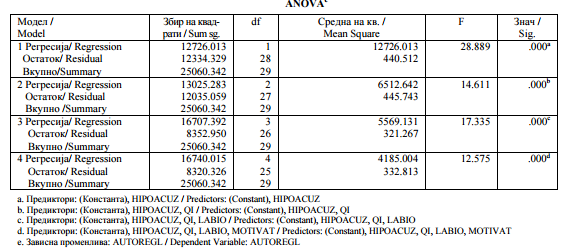
|
Моделот покажува дека индикаторот загуба на слухот ја објаснува 49% од варијацијата на саморегулативната променлива.
Според третиот модел (III), индикаторит оштетување на слухот, способност за читање од уста и IQ објаснуваaт 62.8% од варијација на саморегулативната променлива. |
|
Model shows that the hearing loss predictor explains 49% of the variation of the self-regulation variable. |
|
|
|
|
|
Табела 3. Коефициенти-мултипна линеарна регресија за сите степени на оштетен слух |
|
Table 3. Coefficients - Multiple Linear Regression for all degree of hearing loss |
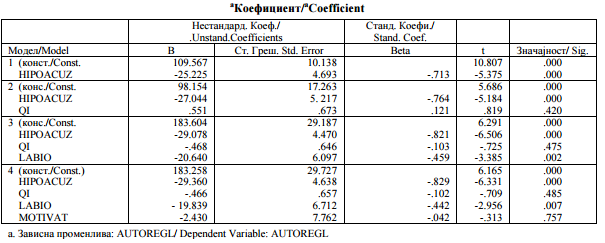
|
Хиерархиски степени на регресија при губење на слухот
ГУБЕЊЕ НА СЛУХОТ = благо оштетување Х |
|
Hierarchical regression degrees of the hearing loss
HEARING LOSS= mild H |
|
Табела 5. Анова - мултипна линеарна регресија кај лесно оштетување на слухот |
|
Table 5. Anova - Multiple Linear Regression for mild hearing loss |
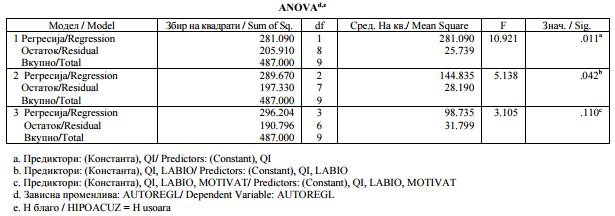
|
Според тоа, IQ индикаторотобјаснува 52.4% одваријацијатанасаморегулаторнатапроменлива. Читањетоодуснии IQ индикаторитеобајснуваат 47.9% одваријацијатакајсаморегулативнатапроменлива. (Табела 4) |
|
Thus, the IQ predictor explained 52.4% of the variance of the self-regulation variable. The lip-reading ability and the IQ predictors explain 47.9% of the variance of the self-regulation variable. (Table 4) |
|
Table 4. Резиме на моделот - мултипна линеарна регресија применета кај лесно оштетување на слухот |
|
Table 4. Model Summary - Multiple Linear Regression applied for mild hearing loss |

|
Следи заклучокот дека мотивацијата, читањето од усни и IQ индикаторите објаснуваат 41.2% од варијацијата на саморегулативната променлива. Моделот III не ја објаснува значајната пропорција на варијација на саморегулативната променлива. |
|
The conclusion is that the motivation, the lip-reading ability and the IQ predictors explain 41.2% of the variance of the self-regulation variable. Model III does not explain a significant proportion of the variance of the self-regulation variable. |
|
Tабела 6. Коефициенти - мултипна линеарна регресија кај лесно оштетување на слухот |
|
Table 6.Coefficients - Multiple Linear Regression for mild hearing loss |
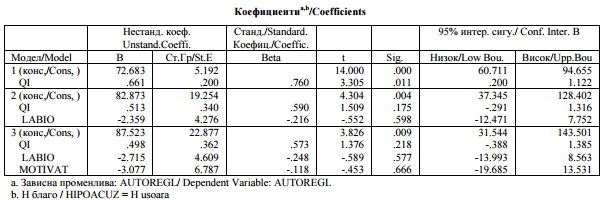
|
ГУБЕЊЕ НА СЛУХОТ = При лесно губење на слухот кај ниту еден модел не беше најдена значајност. (Tабели 7 и 8) |
|
HEARING LOSS= None of the models was found significant for the mild hearing loss. (Tables 7 and 8) |
|
Табела 7. Резиме на моделот - мултиплицитна линеарна регресија применета кај средно оштетување на слухот. |
|
Table 7. Model Summary - Multiple Linear Regression applied for medium hearing loss |

|
Во првиот (I) модел, IQ индикаторотобјаснува 9% од варијацијатана саморегулаторнатапроменлива. Во вториот (II) модел, способностзачитањеодустаи IQ индикаторитеобјаснуваат 16.2% од варијацијатакајсаморегулативнатапроменлива. |
|
In the first (I) Model, the QI predictor explains 9% of the variance of the self-regulation variable. |
|
Табела 8.Анова– Мултипна линеарна регресија кај средно оштетување на слухот |
|
Table 8. Anova - Multiple Linear Regression for medium hearing loss |
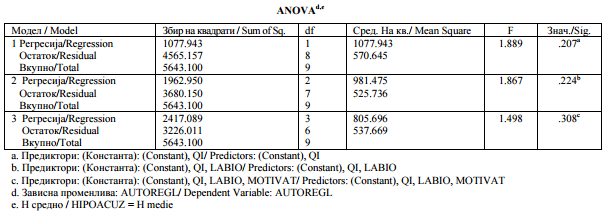
|
Табела 9. Коефициент - мултипна линеарна регресија кај средно оштетување на слухот |
|
Table 9. Coefficients - Multiple Linear Regression for medium hearing loss |
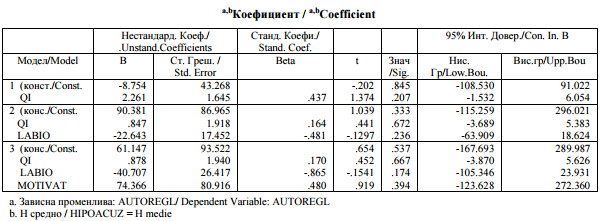
|
ГУБЕЊЕНАСЛУХОТ= Сите три модели објаснија значителна пропорција на варијацијата на само-регулативната променлива. (Табела 10) |
|
HEARING LOSS= All three models explained a significant proportion of the variance of the self-regulation variable. (Table 10) |
|
|
|
|
|
Табела 10. Анова – мултипна линеарна регресија кај тешко оштетување на слухот |
|
Table 10. Anova - Multiple Linear Regression for severe hearing loss |
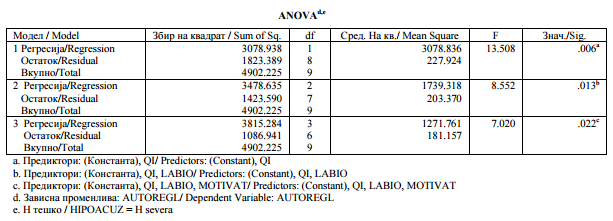
|
IQ индикаторотобјаснува 58.2% од варијацијатакајсаморегулативнатапроменлива. |
|
The IQ predictor explains 58.2% of the variance of the self-regulation variable. |
|
Табела 11. Резиме на моделот - мултипна линеарна регресија кај тешко оштетување на слухот |
|
Table 11. Model Summary - Multiple Linear Regression applied for severe hearing loss |

|
Хиерархијата на предикторите во моделот на тешко оштетување на слухот е како што следува: IQ (t = 1.989, p = 0.094) > читањеодусни (t = 1.980, p = 0.095) > мотивација (t = 1.363, p = 0.222), (Tабела 12). |
|
The hierarchy of predictors in the model of severe hearing loss is as follows: IQ (t = 1.989, p = 0.094) > lip-reading ability (t = 1.980, p = 0.095) > motivation (t = 1.363, p = 0.222), (Table 12). |
|
Табела 12. Коефициенти - мултипна линеарна регресија кај тешко оштетување на слухот |
|
Table 12. Coefficients - Multiple Linear Regression for severe hearing loss |
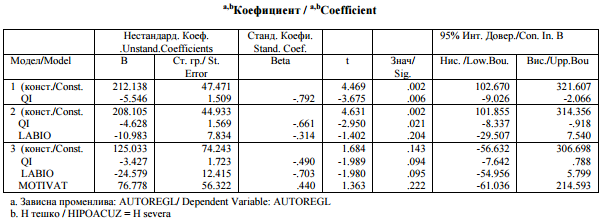
|
Анализа на мрежата за набљудување
За да се постигне регулирање на комуникацијата кај децата со умерено или тешко оштетување на слухот, моделот е комбинација од моторно-вербалниот и усно-визуелниот модел и семантичка содржина на пораката. Откако двата модела (моторно-вербалниот и усно-визуелниот) се исправно и цврсто врежани во асоцијативната меморија, визулената компонента може да предизвика визуелно-моторни движења соодветно, кои ја поддржуваат мислата и имагинацијата. Децата исто така изговараа точно и со користењето на дактилен јазик.
|
|
Analysis of the observation grid
In order to achieve regulation in the communication among children with medium and severe hearing loss, the model is a combination of the motor-verbal and the lip-visual models and the semantic content of the message. After both models (motor-verbal and lip-visual) are correctly and firmly embraced in the associative memory, the visual component may activate appropriate visual-motor movements to support the thought and the imagination. The children also pronounced correctly when they used the dactyl language as well.
|
||
|
Дискусија |
|
Discussion |
||
|
|
|
|
||
|
Саморегулацискиот говор може да се појави при било кој степен на оштетување на слухот, особено кај децата со лесен степен на оштетување на слухот, во зависност од нивото на интелигенција, нивото на способноста за читање од усни и внатрешната мотивација, како и од личните особини на детето. Во спротивно, тие мора да придонесат за рана интервенција и конкретна терапија. |
|
The self-regulated speech can occur at any degree of hearing loss, especially in children with mild hearing impairment, depending on the level of intelligence, the level of lip reading and intrinsic motivation, aswell as the personality traits of the impaired child. To the contrary, they must contribute to the early intervention and specific therapy. |
||
|
|
|
|
||
|
Заклучок |
|
Conclusion |
||
|
|
|
|
||
|
Саморегулативниот говор може да се појави кај секое лице со оштетен слух, без оглед на степенот на оштетување, во зависност од нивото на способноста за читање од усни и степенот на интелигенција. Тој исто така зависи и од внатрешната мотивација и особено од моментот кога детето ќе започне да го носи помагалото и да го учи јазикот.
|
|
The self-regulated speec
h can occur in any degree of hearing loss, depending on the level of lip-reading ability and the degree of intelligence of the child. It also depends on the intrinsic motivation and especially on the moment the child started to wear the prosthesis and learn the language.
|
||
|
Citation:Ghergut A, Paduraru L. Self-Regulation Strategies of Oral Communication in Children with Hearing Impairment. J Spec Educ Rehab 2011; 12(3-4):7-24. doi: 10.2478/v10215-011-0008-4 |
||||
|
Article Level Metrics |
||||
|
Литература / References |
|
|
||
|
|
|
||
Share Us
Journal metrics
-
 SNIP 0.059
SNIP 0.059 -
 IPP 0.07
IPP 0.07 -
 SJR 0.13
SJR 0.13 -
 h5-index 7
h5-index 7 -
 Google-based impact factor: 0.68
Google-based impact factor: 0.68
10 Most Read Articles
- PARENTAL ACCEPTANCE / REJECTION AND EMOTIONAL INTELLIGENCE AMONG ADOLESCENTS WITH AND WITHOUT DELINQUENT BEHAVIOR
- RELATIONSHIP BETWEEN LIFE BUILDING SKILLS AND SOCIAL ADJUSTMENT OF STUDENTS WITH HEARING IMPAIRMENT: IMPLICATIONS FOR COUNSELING
- EXPERIENCES FROM THE EDUCATIONAL SYSTEM – NARRATIVES OF PARENTS WITH CHILDREN WITH DISABILITIES IN CROATIA
- INOVATIONS IN THERAPY OF AUTISM
- AUTISM AND TUBEROUS SCLEROSIS
- THE DURATION AND PHASES OF QUALITATIVE RESEARCH
- REHABILITATION OF PERSONS WITH CEREBRAL PALSY
- DISORDERED ATTENTION AS NEUROPSYCHOLOGICAL COGNITIVE DISFUNCTION
- HYPERACTIVE CHILD`S DISTURBED ATTENTION AS THE MOST COMMON CAUSE FOR LIGHT FORMS OF MENTAL DEFICIENCY
- DIAGNOSTIC AND TREATMENT OPTIONS IN AUTISTIC SPECTRUM DISORDERS – AN OVERVIEW

















